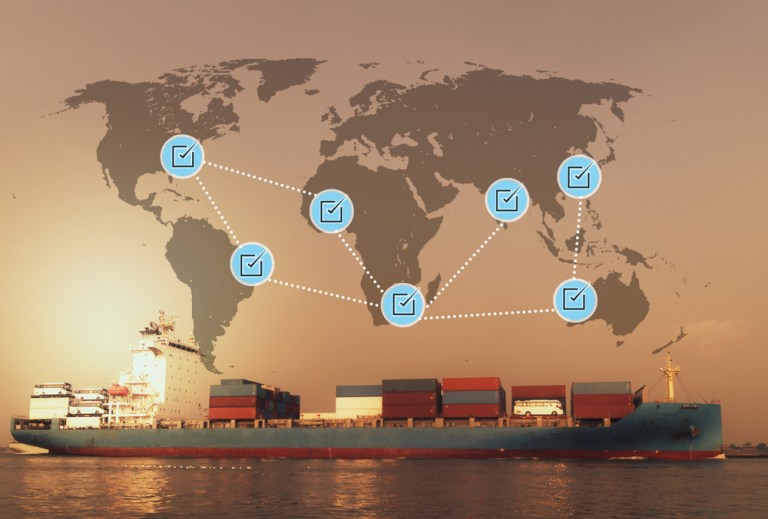
The risks companies expose themselves to via their supply chains cannot be overstated: from supplier insolvency, to failure to deliver products, to noncompliance, to cyberattacks and warfare.
Despite these threats, companies are struggling to adequately vet and manage their vendor base. Less than two-thirds of businesses surveyed by Thomson Reuters in 2016 said they complete due diligence on their third-party partners, including suppliers – and those that do are only assessing tier 1 suppliers, resulting in a lack of visibility beyond the first level of vendors in their supply chains.
Among the largest challenges for companies looking to vet their suppliers, explained Hope Liu, co-founder and CEO of supply chain finance company Eximchain, is that the options to adequately assess these companies are limited.
“Nowadays,” she told PYMNTS, “if you want to find reputable suppliers, you have three options: Go to an agent or someone you trust for recommendation, [use] Google, [or] make a few trips overseas and spend a few months to vet the supplier.”
The shortcomings of these opportunities are clear, yet the risks of lackluster supplier vetting are huge.
“We have seen and heard so [many] cases of companies using fake identities, or taking an order out of their capacity but outsourcing them to other factories with a surcharge,” Liu said.
Sixty-one percent of companies surveyed by Thomson Reuters said they have “no idea as to the extent to which third parties are outsourcing their work.” This means heightened costs without the ability to know (or trust) materials used or businesses involved in any order.
On the financial side, higher costs are only part of the overall risks businesses face by failing to adequately vet suppliers.
“A lot of time and money is wasted during [the vetting] process, while in the end, the buyer is still not sure whether the authenticity of suppliers is fully verified,” Liu noted.
According to the company, the partnership aims to address the domino effects of inadequate vetting. One bad actor in the supply chain may fail to deliver on an order to a buyer, and if that buyer is a supplier to another buyer, that failure resonates far and wide. One supplier’s noncompliance can mean that all of its business partners are liable, too. If one vendor pays its own supplier late, that supplier faces the risk of insolvency, threatening the supply chain further upstream.
This lack of transparency also has implications for access to finance, explained Liu.
“We have also seen reputable suppliers having a hard time using their previous record to prove their authenticity,” she said. “There is no trustworthy database for suppliers and buyers to securely share past business records without revealing confidential information to make the process transparent.”
Liu added that not only does it make it more difficult for companies to gain visibility into their supply chains, it also makes it tougher for companies to prove their creditworthiness to a lender.
“Upstream suppliers and raw materials providers face difficulty turning their credibility into supply chain financing because they can’t bring their past transaction records to the bank to prove their reputation, and they can’t prove the end buyer of their product is a multinational company due to a lack of transparency across upstream and downstream supply chains,” she said.
Companies are not blind to the risks of a lack of supplier vetting: Protiviti’s 2017 Vendor Risk Management Survey found that more than half of businesses said they plan to exit or “de-risk” third-party relationships they have found to pose the greatest amount of risk to their businesses.
But supplier risk assessment is not a one-and-done process. Recently, Eximchain enhanced its supplier vetting capabilities through a collaboration with YOOSourcing, a partnership that addresses the link between supplier vetting and access to trade finance. Users on the Eximchain platform can take the initiative to bolster their reputations as suppliers, the companies explained, strengthening their positions to access capital.
With most lenders only recognizing fixed assets as collateral, while also requiring a direct relationship with a multinational corporation to provide supply chain financing, suppliers further down the supply chain without those ties to major firms are struggling the most to gain the capital they need.
Making matters worse, Liu added, is that these suppliers – tier 2, 3 and so on – are often the most strapped for cash.
“Upstream suppliers and raw material providers are the ones who suffer the cash flow issue, since they have to deliver goods early but receive cash later, without much bargaining power,” she pointed out. “This creates a potential supply chain disruption problem, since the break of cash flow of upstream suppliers and raw materials, as well as reduced quality, will eventually reflect in the final goods that multinational companies receive.”
According to Liu, while suppliers are clearly at risk for cash crunches, the companies at the end of the supply chain expose themselves to the knock-on effects of that struggle. Ensuring supply chain transparency and adequate access to finance for all vendors is beneficial to everyone involved, she added.
“In order to prevent this from happening, and to have proper control of the supply chain upstream, multinational companies with global supply chains have to heighten supplier risk management to enable upstream suppliers and raw materials providers to prove their end buy, and leverage big companies’ credits, to gain supply chain financing.”